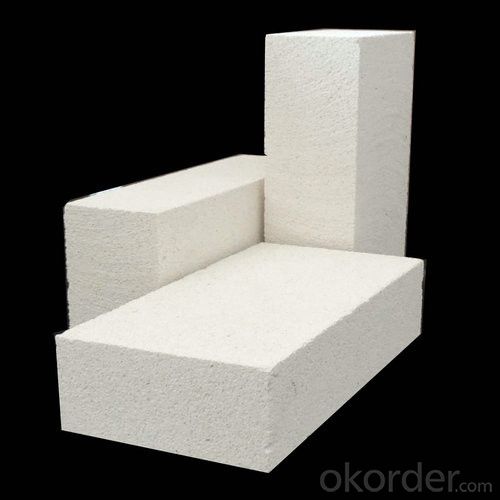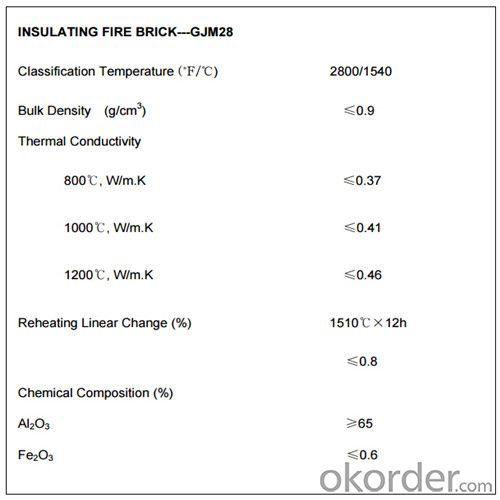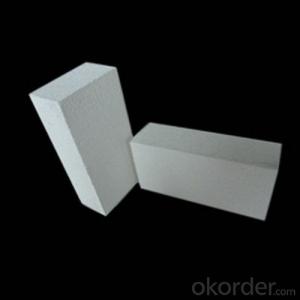Insulation Fire Bricks High Temperature Resistance
- Loading Port:
- Shanghai
- Payment Terms:
- TT or LC
- Min Order Qty:
- 1 m.t.
- Supply Capability:
- 1000 m.t./month
OKorder Service Pledge
OKorder Financial Service
You Might Also Like
General Information of Insulation Fire Brick
CMAX Insulation Fire Brick are classified under temperature between 1300℃ to 1700℃, manufactured from high purity alumina clay.
Image of Insulation Fire Brick


Technical Data of Insulation Firebricks

Feature of Insulation Fire Brick
Light weight and low thermal conductivity
Low heat storage
Low iron and impurities
High thermal shock resistance
Application of Insulation Fire Brick
CMAX Insulation Fire Brick can be used as a hot face lining directly exposed to the heat or as a backup insulation layer in iron and steel mills, non-ferrous foundries, petrochemical, ceramic, glass.
Why Choose Us
l We are a government owned company with ISO certificate.
l We are listed in Global Fortune 500 with D & B report.
l We have more than 11 refractory production facilities and bases across China. We have a wide products range, such as ceramic fiber products (ceramic fiber blanket, module, board, paper, bulk), ceramic fiber textile (ceramic fiber rope, cloth, tape, yarn) etc, refractory brick (fireclay brick, high alumina brick, silica brick, magnesia brick etc), monolithic refractory materials, insulating fire brick, calcium silicate board, mica sheet, steel fiber. You can find various products here, and we can combine the light weight ceramic fiber products with the heavy weight refractory brick in one container delivery, then save the sea freight for you.
l We have strict materials selecting system and quality control system. We have the ability to take responsibility for your orders and product quality.
FAQ
Q1: How do you control the products quality?
A1: With strict quality control system throughout the materials selection and production process, our refractory and ceramic fiber products quality is effectively controlled to meet customer requirements.
From the raw materials selecting, our quality control begin. The quality certificates of raw materials are required and each batch will be tested before using. During production, the quality control are conducted by workers and then each piece will be sorted and examined by quality supervis
Q2: What`s the lead time for my order?
A2: It depends on customers’ requirements and our production schedule. And usually we need 30-60 days for refractory bricks,10-25 days for unshaped refractory materials and 10-20 days for ceramic fiber blankets.
Q3: Can you offer Door-to-Door delivery?
A3: Yes, but only for some countries such us U.S., UAE, Saudi Arabia, Iran, and Russia, etc.
Q4: What is the minimum quantity?
A4: There is no minimum order quantity. Depending on the item and processing, there may be a minimum production required, however we can offer a quotation based only on the quantity you need.
Q5: Can you give me a brief introduction of the application of your products?
A5: CNBM (China National Building Material) core refractory business comprises the production, sale and installation of high-grade refractory products, the development and implementation of customized system solutions as well as rendering outstanding services for the key industries in Glass, Iron& Steel, Petrochemical, Cement, Ceramic and Nonferrous Metals.
- Q:Can insulating fire bricks be used in the construction of thermal oxidizers?
- Yes, insulating fire bricks can be used in the construction of thermal oxidizers. Insulating fire bricks have excellent thermal insulation properties, which make them ideal for applications where high temperatures need to be contained within a specific area. Thermal oxidizers are used to combust volatile organic compounds (VOCs) at high temperatures, and the use of insulating fire bricks can help maintain the required temperature within the combustion chamber while minimizing heat loss to the surroundings. Additionally, insulating fire bricks are lightweight, durable, and have good resistance to thermal shock, which further contributes to their suitability for use in thermal oxidizers.
- Q:Can insulating fire bricks be used in glass furnaces?
- Glass furnaces can indeed utilize insulating fire bricks. These bricks are specifically engineered with low thermal conductivity, rendering them ideal for high-temperature environments such as glass furnaces. The implementation of these bricks aids in the reduction of heat loss from the furnace, consequently enhancing energy efficiency and decreasing operational expenses. Moreover, they offer superior insulation and aid in maintaining consistent temperatures within the furnace, a vital factor in glass production. Furthermore, insulating fire bricks exhibit excellent resistance to thermal shock and can endure the extreme temperatures and rapid temperature fluctuations that are common in glass furnaces. Overall, integrating insulating fire bricks into glass furnaces can result in enhanced furnace performance, heightened productivity, and energy conservation.
- Q:Are insulating fire bricks resistant to weathering?
- Insulating fire bricks have remarkable resistance to weathering. Crafted from top-notch refractory materials, these bricks are engineered to endure severe temperatures and rugged weather conditions. They are designed to exhibit exceptional resistance against thermal shock, erosion, and corrosion induced by exposure to diverse weather elements like rain, snow, wind, and sunlight. Moreover, insulating fire bricks possess resistance to chemical assaults, establishing their durability and suitability for long-term outdoor applications. In summary, the formidable composition and weathering resilience of insulating fire bricks render them a dependable option for insulation and construction needs in outdoor settings.
- Q:Can insulating fire bricks be used in the construction of industrial dryers?
- Yes, insulating fire bricks can be used in the construction of industrial dryers. These bricks have excellent thermal insulation properties, which make them ideal for retaining heat within the dryer and reducing heat loss. Additionally, insulating fire bricks are resistant to high temperatures, making them suitable for the extreme heat generated in industrial dryers.
- Q:Are insulating fire bricks resistant to thermal radiation?
- Indeed, insulating fire bricks exhibit resistance to thermal radiation. These bricks possess a unique design that grants them outstanding thermal insulation properties, enabling them to effectively combat and minimize heat transfer via radiation. Typically composed of materials like alumina, silica, or fire clay, which boast high melting points and low thermal conductivity, insulating fire bricks possess the ideal attributes to withstand elevated temperatures and impede the transmission of thermal energy through radiation. Consequently, they serve as an appropriate option for various applications necessitating thermal insulation, including kilns, furnaces, and fireplaces.
- Q:Is it possible to paint or coat insulating fire bricks?
- Yes, it is possible to paint or coat insulating fire bricks. However, it is important to use a paint or coating that can withstand high temperatures, as insulating fire bricks are designed to be used in extremely hot environments. Regular paint or coatings may not be suitable as they can burn or deteriorate when exposed to high temperatures. It is recommended to use specialized high temperature paint or coatings that are specifically formulated to withstand the heat of insulating fire bricks. These paints or coatings typically have a high temperature resistance of several hundred degrees Celsius or more. Additionally, it is important to properly clean and prepare the surface of the bricks before applying any paint or coating to ensure good adhesion and durability.
- Q:Can insulating fire bricks be used in space heating applications?
- Yes, insulating fire bricks can be used in space heating applications. Insulating fire bricks are designed to have low thermal conductivity, which means they can effectively retain and distribute heat in a space heating system. These bricks are made from lightweight refractory materials that have excellent insulation properties, allowing them to trap heat and prevent its loss to the surroundings. This makes them ideal for use in space heating applications where energy efficiency is important. Additionally, insulating fire bricks can withstand high temperatures and are resistant to thermal shock, making them suitable for use in heating systems that operate at elevated temperatures. Overall, insulating fire bricks are a reliable and efficient option for space heating applications.
- Q:Can insulating fire bricks be used in the construction of lime calciners?
- Indeed, the utilization of insulating fire bricks is feasible when constructing lime calciners. Lime calciners necessitate elevated temperatures for lime production, and insulating fire bricks are specifically engineered to endure and preserve heat. These bricks possess a reduced thermal conductivity, which effectively insulates the calciner and impedes heat dissipation. Furthermore, insulating fire bricks are lightweight, facilitating their handling and installation during the lime calciners' construction process.
- Q:What kind of mortar is used to bond insulating fire bricks together?
- Refractory mortar, consisting of a blend of high-temperature resistant components like silica, alumina, and fire clay, is extensively employed to unite insulating fire bricks. Custom-made to endure extreme temperatures and offer exceptional adhesion, refractory mortar is the prevailing choice for firebrick applications. Notably, this mortar type exhibits remarkable resistance to thermal shock, rendering it perfect for bonding insulating fire bricks utilized in furnaces, kilns, and other settings with elevated temperatures.
- Q:Can insulating fire bricks be used in the construction of lime production linings?
- Yes, insulating fire bricks can be used in the construction of lime production linings. Insulating fire bricks are designed to have low thermal conductivity, which makes them excellent for applications where heat insulation is required. In lime production, high temperatures are required for the calcination process. Using insulating fire bricks in the construction of lime production linings helps to reduce heat loss and improve energy efficiency. Additionally, insulating fire bricks are lightweight and easy to handle, which makes them suitable for lining various parts of lime kilns and other equipment used in the lime production process. Overall, using insulating fire bricks in lime production linings can help to optimize the production process and improve the overall performance of lime production facilities.
1. Manufacturer Overview |
|
|---|---|
| Location | |
| Year Established | |
| Annual Output Value | |
| Main Markets | |
| Company Certifications | |
2. Manufacturer Certificates |
|
|---|---|
| a) Certification Name | |
| Range | |
| Reference | |
| Validity Period | |
3. Manufacturer Capability |
|
|---|---|
| a)Trade Capacity | |
| Nearest Port | |
| Export Percentage | |
| No.of Employees in Trade Department | |
| Language Spoken: | |
| b)Factory Information | |
| Factory Size: | |
| No. of Production Lines | |
| Contract Manufacturing | |
| Product Price Range | |
Send your message to us
Insulation Fire Bricks High Temperature Resistance
- Loading Port:
- Shanghai
- Payment Terms:
- TT or LC
- Min Order Qty:
- 1 m.t.
- Supply Capability:
- 1000 m.t./month
OKorder Service Pledge
OKorder Financial Service
Similar products
New products
Hot products
Related keywords





























